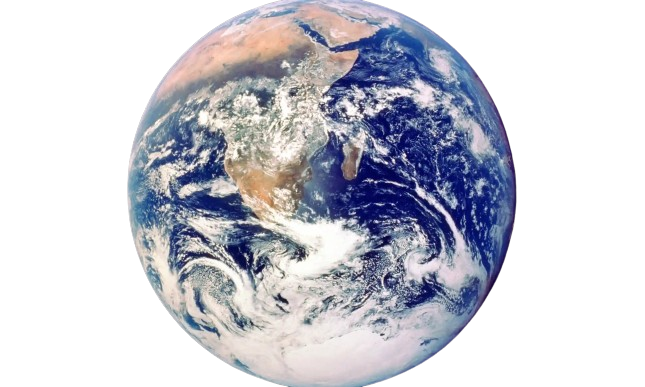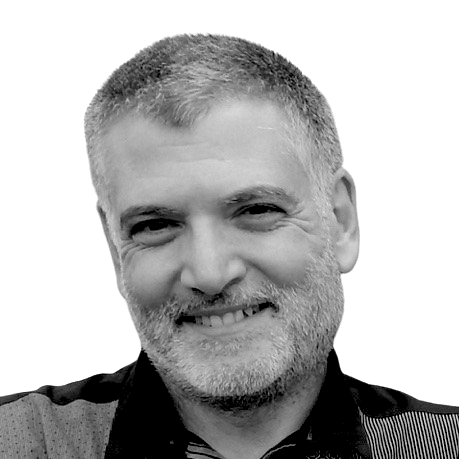Winners
We are thrilled to showcase the incredible winning entries from the 2024 International Space for Earth – Space for All Design Challenge. These exceptional works highlight the creativity, innovation, and dedication of young minds as they explore imaginative solutions inspired by space technologies and their applications for improving life on Earth.
We extend our heartfelt gratitude to the following schools and teachers, who dedicated their time and effort to guiding their students through this project and inspiring them to think creatively and critically:
New Mexico
- Taos Middle School – Christine Autumn
- Mandela International Charter School– Kelly Rider
- Digital Arts and Technology Academy– Michelle Godfrey
- Santa Fe Indian School- Kate Sallah
Mexico
- Preparatoria Regional De Huejuquilla El Alto – Diana Caldera Moreno, Fabián García Varela and Esperanza Marcela Hernández Aguayo
- Preparatoria San Jose Del Valle – Jose Luis Bernal Contreras Anabel Gómez Valdivia, José Armando Rosas Santillán José Adrián López Ramírez
- Julio Cesar Hernández Ochoa, Karla Susana Prospero Escobedo, Lizda Denisse Gómez Villegas, Angel Moises Barragan Gonzalez, Josué Aguilar Lopez
- Preparatoria #5 Universidad de Guadalajara – Lorena Berenice Jasso Arámbula
To all the students who submitted their designs, we are inspired by your hard work, unique perspectives, and innovative ideas. Each entry is a testament to your passion and potential to imagine a better future. Thank you for being part of this meaningful journey, and congratulations to the winners for their outstanding achievements!
Mexico
Pahtia
by Cesar Yahir Pamaz
Preparatoria San Jose del Valle

After extensive research, we decided to develop a super plant through bacterial endosymbiosis, leveraging the cutting edge of biotechnology. To achieve this, we selected two compatible and effective organisms: Bouteloua gracilis and cyanophyte algae, specifically cyanobacteria of the Anabaena variabilis type. These species undergo rigorous preparation and conditioning, followed by genomic editing to modify their genes and facilitate proper endosymbiosis. Using microinjection, we integrate the cyanobacteria into the cells of Bouteloua gracilis, significantly enhancing the plant’s photosynthetic process.
To bring this project to fruition, we utilized advanced technologies, including genomic editing and microinjection for biotechnological processes, as well as Space4SDGs satellites to monitor plant progress and health continuously. This integration of bacterial endosymbiosis combines Bouteloua gracilis and cyanobacteria into a single, enhanced species. Employing space technologies, such as Space4SDGs satellites, allows us to monitor the territories where this innovative plant will be introduced, ensuring it contributes positively to soil fertility, biodiversity, and environmental health without causing harm. Our goal is to enhance terrestrial ecosystems and foster a sustainable balance.
We selected Bouteloua gracilis because it is one of the most common species in Mexico and native to North America. It is a fast-growing, hardy plant with a high reproductive capacity, though it is non-invasive and beneficial to other species. Additionally, it is a nutrient-rich forage plant suitable for animal consumption. When combined with cyanobacteria, which are renowned for their superior photosynthetic efficiency and biomass production, the resulting super plant will have unprecedented potential.
The project aims to achieve significant results. It is expected to reduce the carbon footprint by absorbing 10 to 30 tons of CO₂ per hectare annually and produce 10 to 25 tons of oxygen per hectare each year. Furthermore, it will generate 1.8 to 7.3 tons of low-cost biomass per hectare annually and revitalize soil through the process of phytoremediation.
This breakthrough represents more than a scientific milestone; it is a bold step towards a sustainable future where nature and science collaborate to restore and heal the planet. By revitalizing eroded soils, the plant will return essential nutrients to the earth through its long roots and the process of phytoremediation.
Initially, the super plant will be cultivated in controlled environments under close observation by specialists. Once its success is confirmed, it will be introduced to strategic locations where its reproductive ability will allow it to spread naturally. This will benefit countless ecosystems and communities, contributing to a healthier planet.
Our project aligns with several United Nations Sustainable Development Goals, including Climate Action by reducing carbon emissions and increasing oxygen production, Life on Land by improving conditions for biodiversity without harming ecosystems, and Affordable and Clean Energy through the generation of low-cost biomass for sustainable use.
This ambitious endeavor will not cease until we witness a significant improvement in the Earth’s environment and human well-being, marking a transformative moment in our relationship with the planet.
Our revolutionary project has as its elemental objective to create a plant that will ensure life on Earth in the future.
TerraBreath
by Jorge Octavio Torres Sedano, Luis Antonio Hueso Rodriguez
Preparatoria San Jose del Valle
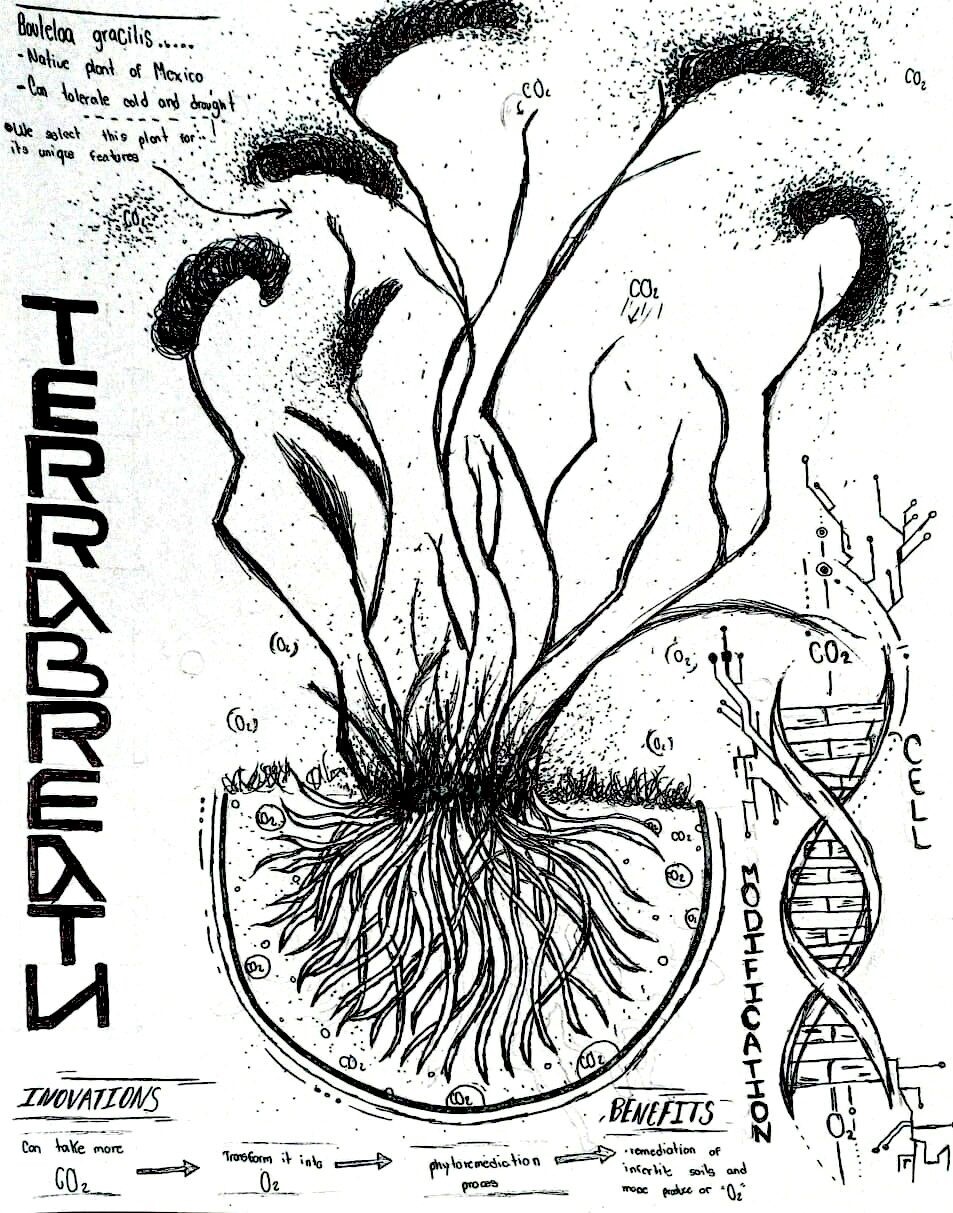
After extensive research, we embarked on the development of a super plant through bacterial endosymbiosis, leveraging the forefront of biotechnology. This endeavor involves the selection of two highly compatible and effective species: Bouteloua gracilis and cyanophyte algae, specifically Anabaena variabilis. These organisms undergo meticulous preparation and conditioning, followed by genomic editing to modify their genes and enable proper endosymbiosis. Using microinjection, we integrate cyanobacteria into the cells of Bouteloua gracilis, significantly enhancing its photosynthetic capacity.
The project incorporates cutting-edge technologies, including genomic editing and microinjection for biological integration, alongside the deployment of Space4SDGs satellites to monitor the health and progress of the plants. By combining Bouteloua gracilis with cyanobacteria, we aim to create a novel species with enhanced photosynthetic efficiency and biomass production.
This initiative extends beyond the lab. Space technologies, such as Space4SDGs satellites, will monitor the territories where the super plant is introduced, allowing us to track improvements in soil fertility while ensuring the plant does not adversely affect terrestrial biodiversity. Instead, it will actively enhance ecological balance.
We chose Bouteloua gracilis, a native North American species and one of the most common in Mexico, for its fast growth and resilience. While some consider it invasive due to its reproductive capacity, it coexists harmoniously with other species. Moreover, it serves as a nutrient-rich forage plant suitable for animal consumption. When paired with cyanobacteria—renowned for their superior photosynthetic processes and biomass productivity—the synergy unlocks the full potential of this project.
The anticipated results of the super plant are remarkable. It is expected to reduce carbon footprints by absorbing 10 to 30 tons of CO₂ per hectare annually, while producing 10 to 25 tons of oxygen each year. Additionally, the plant will generate 1.8 to 7.3 tons of low-cost biomass per hectare annually and contribute to soil revitalization through phytoremediation. These outcomes not only represent a scientific breakthrough but also signify a transformative step towards a more sustainable future, where nature and technology collaborate to heal the planet.
Thanks to this synergy, we envision widespread adoption of the super plant across terrestrial spaces, contributing to the recovery of eroded soils. Its long roots will facilitate phytoremediation, restoring soil nutrients and promoting ecological balance. Initially, a limited number of specimens will be cultivated under careful observation by specialized personnel. Once their success is validated, the plant will be strategically introduced to various locations, where its natural reproductive capacity will allow it to spread and benefit ecosystems and communities worldwide.
This project aligns with several United Nations Sustainable Development Goals, including Climate Action by reducing CO₂ emissions and increasing oxygen production, Life on Land by enhancing conditions for biodiversity, and Affordable and Clean Energy by leveraging low-cost biomass generation. This ambitious initiative aims to foster an exponential improvement in the Earth’s environment and human well-being, marking a transformative moment in our relationship with the planet.
ThermoClothing
by Luis Manuel Arana Olivera, Sarah Paola Ramírez Arreola, Yosef Dilan Temores Aldana
Preparatoria San Jose del Valle
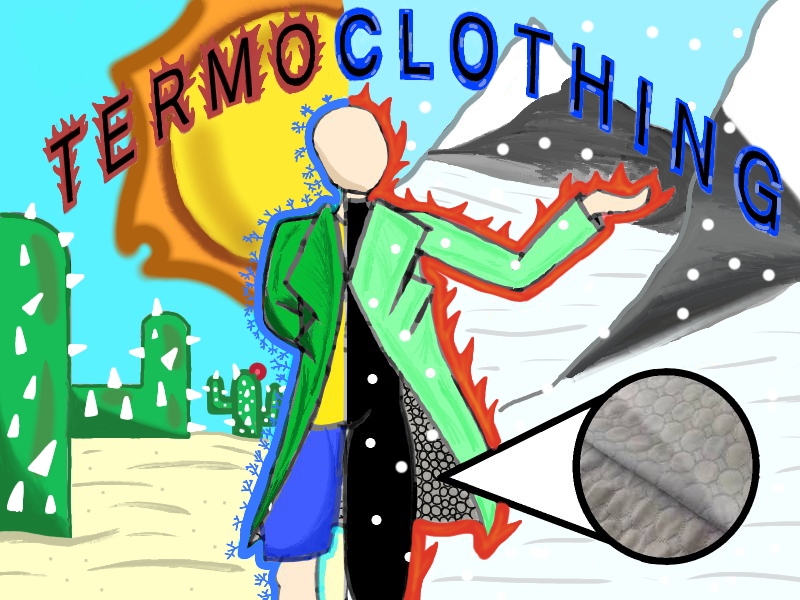
Fast fashion and the constant demand for specialized garments for hot, cold, or variable temperatures have led to increased waste, energy consumption, and environmental pollution. This growing issue highlights the urgent need for versatile, sustainable clothing solutions that can address these challenges without compromising comfort or functionality.
One promising solution lies in the use of Phase Change Materials (PCM), a technology initially developed for space missions to protect astronauts from extreme temperature fluctuations. PCM fibers work by absorbing, storing, and releasing thermal energy, maintaining a stable temperature. This innovative technology is now being adapted for everyday use in temperature-regulating clothing, offering a sustainable approach to personal climate control.
A garment utilizing PCM technology with manual temperature adjustment could incorporate several key features. Adjustable PCM zones could allow users to target specific areas, such as the torso or back, for heating or cooling, providing personalized control. Designs with adjustable layers or vents could regulate the exposure of PCM fibers to ambient temperatures, enabling users to adapt the level of insulation as needed. Additionally, garments could employ PCMs with varied melting points, ensuring optimal heat retention or release for different body areas based on specific thermal requirements.
PCM technology operates through a process of phase changes—transitioning from solid to liquid and back—where it absorbs excess heat when temperatures rise and releases it when they fall. By 2030, the goal is to make PCM-integrated clothing widely accessible, significantly reducing the need for artificial heating or cooling systems. This aligns with key global objectives, including Climate Action and Responsible Consumption and Production.
The benefits of PCM-integrated clothing for life on Earth are profound. These garments offer enhanced thermal comfort by automatically adapting to variable temperatures, ensuring the wearer remains comfortable in both heat and cold. By reducing reliance on external heating or cooling systems, PCM clothing contributes to greater energy efficiency. Furthermore, lightweight and comfortable designs can replace multiple insulating layers, making them practical and convenient for a wide range of climates and activities.
In the future, PCM clothing could play a transformative role in reducing clothing waste and minimizing environmental impact. By supporting a circular approach to fashion, these garments would address the need for fewer specialized items, ultimately decreasing production demands and textile waste. As PCM technology becomes widely adopted, it could significantly reduce energy consumption for heating and cooling in homes, workplaces, and other settings, fostering a greener planet while improving user comfort and convenience.
Originally designed to regulate astronauts’ temperatures during extreme shifts in space—from the intense heat of direct sunlight to the cold of shadowed areas—PCM technology is now revolutionizing everyday clothing. By enhancing thermal comfort, increasing energy efficiency, and offering lightweight, practical designs, PCM fibers promise a future of sustainable and adaptable fashion that benefits both humanity and the environment.
Zapatos Camaleón
by Alejandra Sanchez Raygoza
Preparatoria Regional de Huejuquilla el Alto
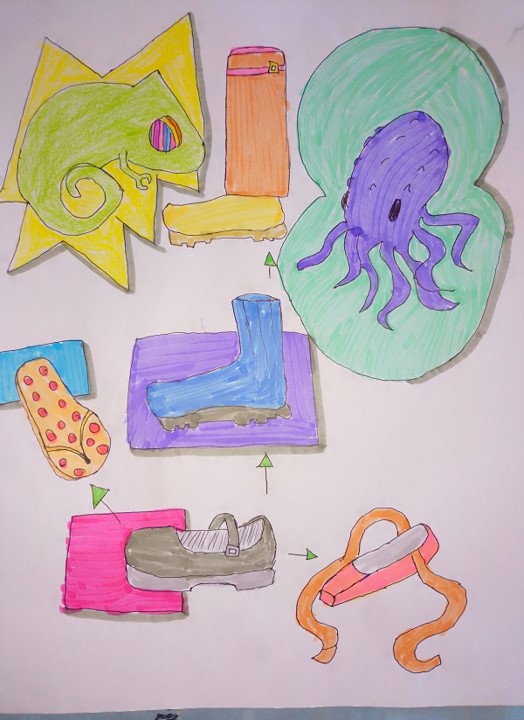
The purpose of these shoes is to reduce consumerism, solid waste, poverty, climate change, and pollution. The goal is to provide an alternative for always being fashionable without making unnecessary expenses. To make this possible, the plan is to replicate artificially the camouflage and defense mechanisms of one of the most fascinating creatures in the ocean, the octopus. In order to achieve this, chromatophores will need to be used. These chromatophores contain pigments that change color depending on the expansion or contraction of the cell. The shoes will be designed to be soft and flexible, just like the radial muscles that surround the chromatophores and control their size.
To achieve changes in texture and shape, octopuses use papillae (small protrusions on the skin that can be raised or flattened) and cirri (filamentous structures that can be extended or retracted). A replication of these features will be applied to the fabric so that the shoe can change its color, shape, and texture as needed.
The main features include the ability to change shape and color to match the clothes you are wearing. The temperature self-adjusts to match your body temperature and the surrounding environment. The shoes are breathable and hypoallergenic, self-adjust to the size of your foot and your needs for greater comfort, and are suitable for different aspects of your life, whether for sports, exercise, or home use. The sole is made of memory foam for better support while walking. They utilize anti-wrinkle and dirt-resistant fabric, are waterproof, very affordable for people around the world, and customizable.
The device will harness blood flow to generate electrical energy to power a device inside the human body.
Organic Motor
by Valeria Ávila, Diego Madero Ku, Jack Jereck Duarte
Preparatoria Regional de Huejuquilla el Alto
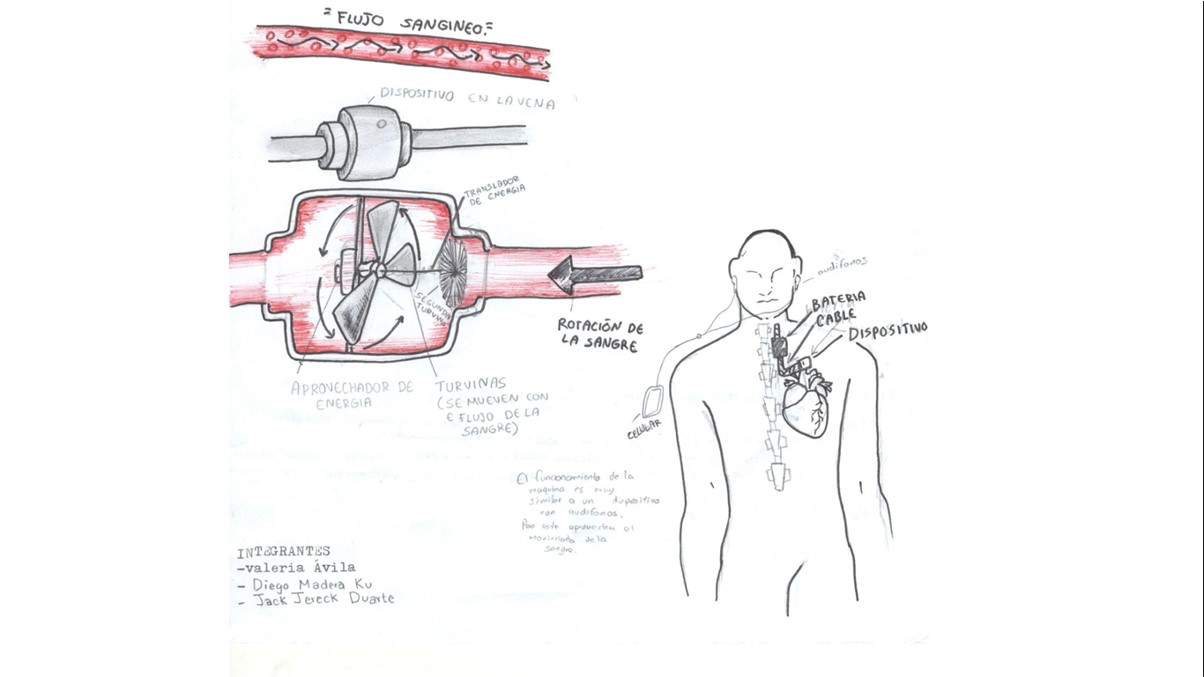
The device will be connected to the veins closest to the heart, as the blood flow is more powerful in this specific area. The blood flow will pass through the device, causing a rotating mechanism (dynamo) to spin, thus generating electricity. This energy will be stored in a separate unit, which will power a device within the human body.
The device will be connected directly to the great cardiac vein. It will consist of three hydraulic blades made of titanium, chosen for its resistance to oxidation and its use in internal projects that involve blood, such as the titanium heart.
The mass receiver will be responsible for receiving and storing the energy, processing it in such a way that the device to which it is connected can utilize the energy generated by the organic motor.
New Mexico
Recycling Robots
by Elora McLarty
Mandela International Magnet School
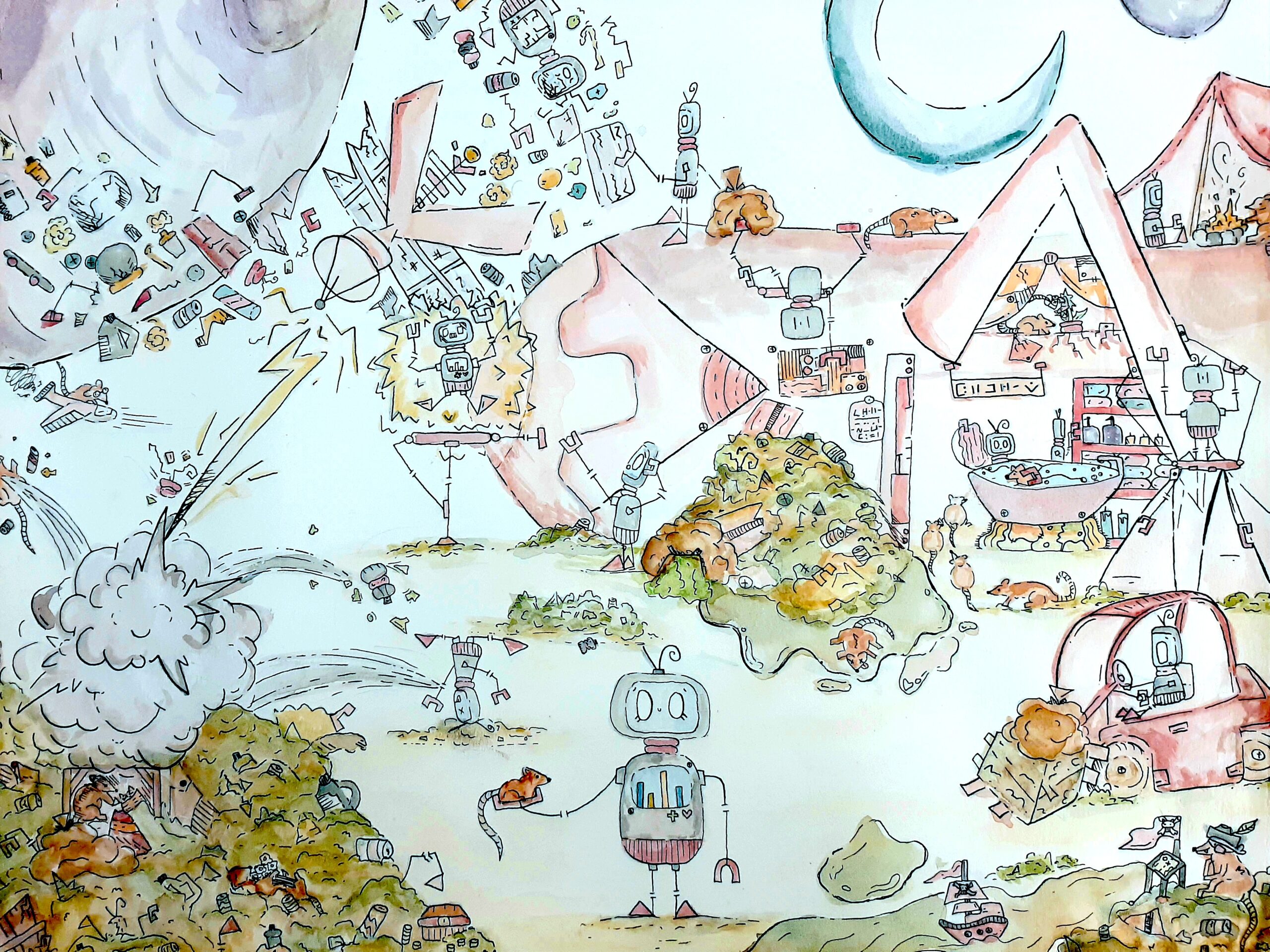
My design is a playful interpretation of the many uses of AI and Technology in the face of the growing amount of trash spreading throughout space. I’ve put a creative spin on robotics and how it can be used to recycle and reuse broken technology to cleanse and restore exotic environments in space. This piece depicts robots designed by NASA that have been sent to a crash site for clean-up purposes, they have the intelligence to identify the trash from the crash site and then scan the waste to determine whether it should be reused, recycled, or stored to be brought back to earth and destroyed. The patches on their stomachs are used to tell how damaged the robot is, if a robot has been broken the message will relay back to earth and humans can decide if the robot should travel back to earth to be fixed or if it would be better taken apart to reuse the scraps. I focused on creating a story for the robots to live in through the painting. I drew numerous intricate scenes that I thought represented what the robots would be doing in their best attempt at a clean-up based on their programming and genuine curiosity. The materials from the crash have been quickly thrown together into inventions, like bathtubs and a forklift, that can easily be used to create more sustainable conditions for the specific planet’s needs. Even the rats have been busy, building themselves pirate ships and planes.
I chose to focus on the sustainable development goal of “Responsible Production and Consumption” and using its targets, “responsible management of chemicals” and “waste and substantially reduce waste generation” to conduct my research on the damages of trash. Reading articles about what trash and pollution have destroyed so far on Earth motivated me to come up with a way to prevent this from happening to other planets. While I was scouring the web for articles on solutions to this problem I noticed that most of the theoretical solutions were eager to use lasers, rocket collision and even stopping space travel as a whole to reduce the amount of waste entering space. However, these ideas didn’t resonate with me as they didn’t feel like the right solution. Instead, I wanted to paint my idea of a peaceful and independent solution using technology that didn’t have the restrictions that humans do. For example, the robots would be able to traverse difficult terrain and navigate seamlessly through dense areas, as the article, “Robots in Biodiversity” by Cathrine Bernier states, “Robots like drones can access remote areas and collect data without bringing along the human presence that can sometimes disturb sensitive habitats”. Additionally, robots wouldn’t need a time constraint on how long they can work because they wouldn’t get tired or need to be supplied with a limited amount of oxygen, this means it will take less time to clean up than if a human astronaut were to be doing the job.
This piece is inspired by a real-world issue, and my hope is that if human curiosity ends up damaging exotic planets through space travel, the same technology can be used to help, not just harm. Trash has ended up being a part of humanity’s everyday life. I believe that we need to be inspired to take action, decontaminate, and restore. Using the technology that was the inspiration for my robots, like drones, landers, and rovers we have every opportunity to do so.
My design is an architectural elevation that represents a futuristic setting, reflecting future sustainable civilizations or structures onto and being utilized on Earth.
Renewable Complex
by Brooke Hickerson
Mandela International Magnet School
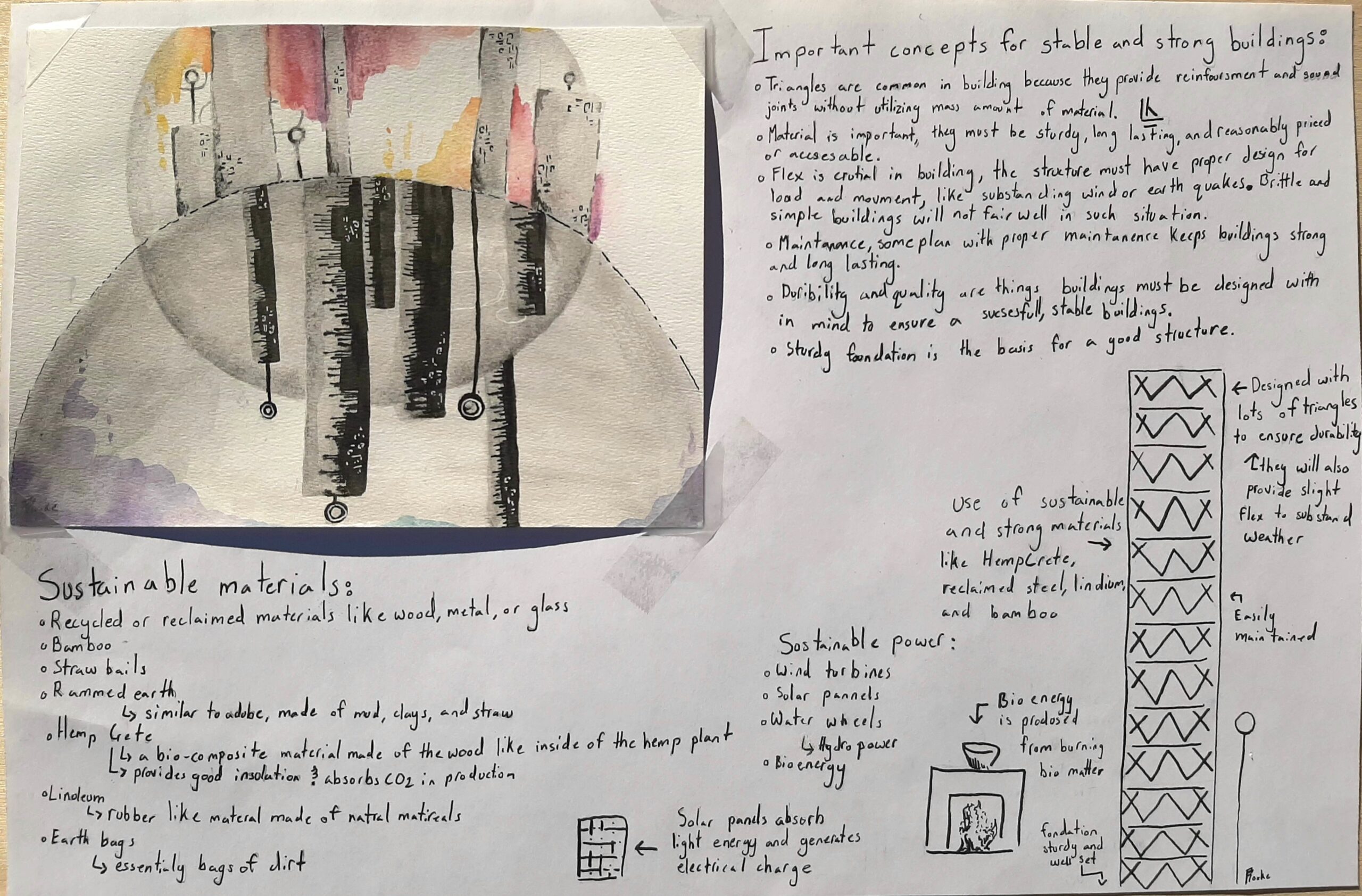
My design is an architectural elevation that envisions a futuristic setting, showcasing sustainable civilizations or structures both on Earth and beyond. The drawing specifically portrays an underwater civilization on Io in the lower half, while the top half features similar structures adapted for Earth. This juxtaposition reflects the concept that advancements and insights gained from space exploration can be applied to improve our own civilizations. Although I lack formal training in architecture, I conducted thorough research to support my ideas.
The inspiration for my design came largely from NASA Spin-Off technologies, which demonstrate how innovations developed for space exploration can benefit everyday life. I was particularly fascinated by advancements in health, such as space shuttle fuel pump technology used to support heart transplant patients and fire-resistant suits based on space suit designs that protect lives in high-risk environments. While my design is not directly related to health, it incorporates similar principles—sustainable development and structural resilience in extreme conditions on other planets—and applies them to Earth.
I focused my research on ice-covered moons like Io, hypothesizing that these environments could harbor water beneath their icy surfaces. Structures built on such moons would need to withstand constant currents and severe weathering. These considerations led me to explore how such techniques could inform the construction of strong, stable structures on Earth, designed to endure extreme weather conditions such as earthquakes, floods, and high winds. My vision includes sustainable, environmentally supportive, and safe communities that can thrive under harsh planetary conditions while preserving the natural environment. To achieve this, my design aligns with the 11th Sustainable Development Goal: sustainable settlements.
Through my research, I identified key factors essential for creating resilient and sustainable structures. First, material choice is critical—materials must be long-lasting, capable of bearing weight, and reasonably accessible. Durability is also a priority, with structures designed to last as long as possible through high-quality construction. A sturdy foundation is essential to provide stability and support for the entire building. Buildings must also be designed for motion, capable of withstanding dynamic forces such as life activity, severe weather, and heavy loads. Structural support designs, like triangular frameworks commonly used in bridges, distribute weight effectively and reinforce joints. Lastly, proper maintenance is indispensable, as even the strongest buildings require consistent upkeep to retain their structural integrity.
Sustainable materials play a vital role in my design. Recycled or reclaimed resources like glass, wood, and metal are excellent options, alongside renewable materials such as bamboo, linoleum, straw bales, and rammed earth (similar to adobe). Among these, I found HempCrete to be one of the most promising materials. HempCrete, a biocomposite made from the woody core of the hemp plant, provides excellent insulation, absorbs CO₂ during processing, and exemplifies sustainable innovation.
In terms of energy, I researched various renewable power sources such as wind, solar, hydro, and bioenergy. While turbine designs for wind or water applications are effective on Earth, I recognize that not all planets have similar weather conditions. Bioenergy, which derives energy from biological sources, appears to be a versatile and renewable option that could work in diverse planetary environments.
This project has deepened my understanding of sustainable building practices and future city concepts, while also highlighting how technological advancements inspired by space exploration can enhance life on Earth. By learning from the challenges and innovations required for extraterrestrial environments, we can develop resilient, eco-friendly structures and communities that improve quality of life both on our planet and beyond.
Suits
by Pascal Heitzman
Mandela International Magnet School
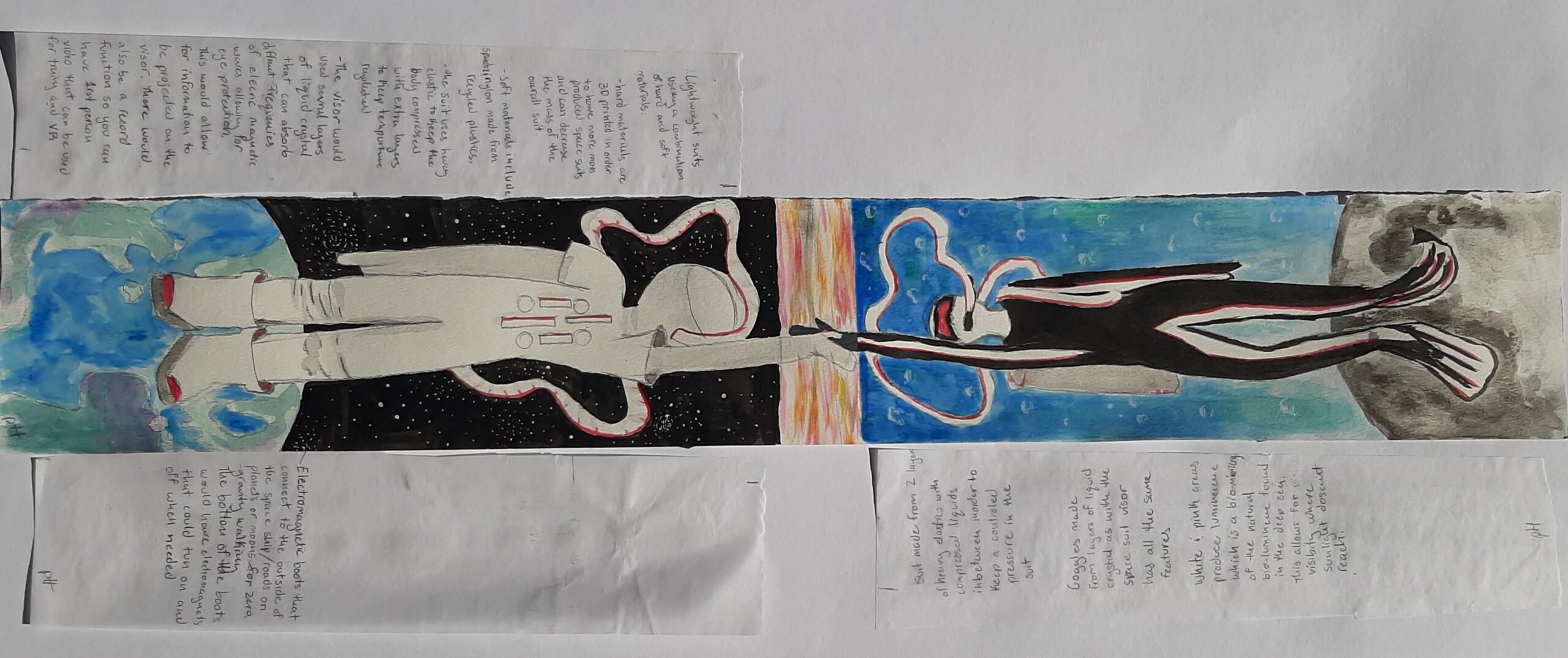
My concept connects deep-sea exploration with space exploration, emphasizing the sustainability goal of “Life Below Water.” The sea has always fascinated me, and I believe it is crucial to remember that while we explore life on other planets, we must also care for our own incredible world. These two realms are deeply interconnected; both the deep sea and space are extreme environments that pose similar challenges to scientists, including extreme pressure differences, intense cold, lack of oxygen, limited food and energy resources, and difficulties with communication. This parallel inspired me to create a design that highlights their connection. My design includes an illustration that visualizes this idea, accompanied by notes for enhancements that could be applied to current space and deep-sea suits. One feature is a liquid crystal visor, designed to protect the eyes from varying ranges of electromagnetic rays, with adjustable settings for different environments. Another is electromagnetic boots, capable of connecting to spaceships or metal structures on low-gravity planets, providing stability and support. Additionally, bioluminescent stripes on deep-sea suits would allow visibility in areas where sunlight cannot penetrate.
These innovations have practical applications for people on Earth. For instance, electromagnetic boots could benefit construction workers operating in high, dangerous locations, offering enhanced safety and support. Bioluminescence could inspire sustainable lighting solutions, reducing energy consumption. Liquid crystal visors could be adapted for use in laser research, offering enhanced protection, or commercialized into advanced sunglasses for everyday use. Overall, this project has pushed me to think creatively and apply scientific knowledge in innovative ways. It has been an exciting exploration of how advancements inspired by extreme environments can be adapted to improve life on Earth while fostering sustainability and innovation.
Jurors
Our esteemed interdisciplinary jury includes:
Dr. Andrea Polli, Artist/Mesa Del Sol Endowed Chair of Digital Media Professor, College of Fine Arts, University of New Mexico
Dr. Michelle Hanlon, Space lawyer/Founder, For All MoonKind, Executive Director of the Center for Air and Space Law at the University of Mississippi School of Law
Dr. Steven Goldfarb, CERN physicist, University of Melbourne, ATLAS Experiment at CERN
Dr. Nicole Lloyd-Ronning, astrophysicist in the Computational Physics and Methods group at Los Alamos National Lab, physics/astronomy professor at UNM-Los Alamos
Alessandro Straccia, Creative Technologist and AR Developer, author of new book release, “Interactive Web Development with Three.js and A-Frame”


